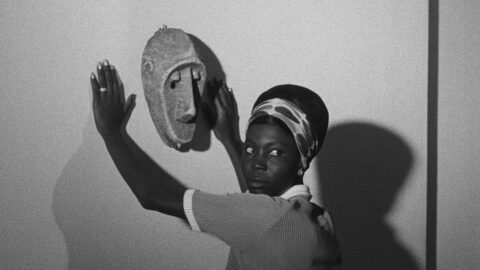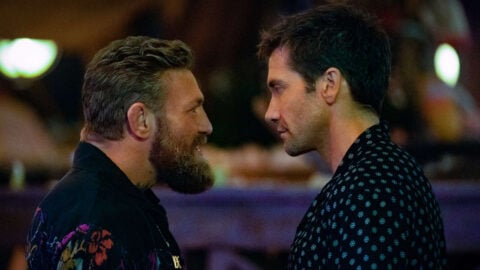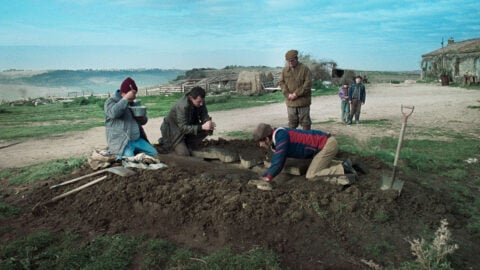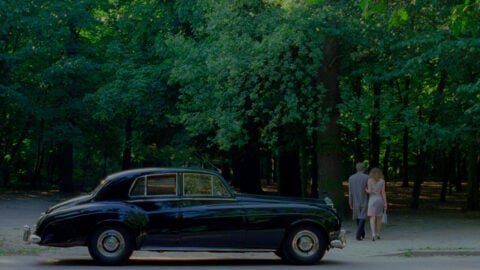
Princess Mononoke
The Japanese eco-fantasist Hayao Miyazaki is an animation magician, a crowd-pleasing storyteller who is also a builder of worlds. He designs meticulously engineered imaginary aircraft, sets their perfect gears spinning, and propels them over moss-green rolling landscapes, zipping between the sprung columns of ruined castles. He uses animation in a refreshingly direct and intuitive way, reveling in its capacity to lift things off the ground.
Miyazaki rarely resorts to computer graphic imagery. In fact, he personally draws up to 70 percent of the individual frames in his movies—80,000 out of 140,000 in his latest, Princess Mononoke (Mononoke Hime, 97), the film that recently surpassed all others at the box office in Japan. But even without the high gloss of CGI, deploying images that appear hand-crafted (a look as distinctively Japanese as the “organic” surface textures of an ancient teacup), he manages to seduce us into believing that these places actually, or at least “virtually,” exist—that they could be turned and tipped and looked at from any angle, and contemplated as a whole.

Princess Mononoke is one of eight films from Miyazaki’s production company, Studio Ghibli, scheduled to be released in the U.S. over the next year or so by Disney. This is a bold move for the master of the Magic Kingdom. For all their family-friendly pluck and luck storylines, their idealized childhood settings, despite even their cute animal sidekicks and nifty fluttering gadgets, these movies will be a novel taste experience for most Americans. In fact, Mononoke may have to be an R-rated release from Disney’s arthouse subsidiary, Miramax—and not only because its samurai-period action includes be-headings and be-limbings.
Picture a mulchy primeval forest of the Muromachi period (A.D. 1333-1568), a pagan paradise menaced by incursions from a nearby village, where bone-chopping steel weapons are being manufactured for the first time. This innovation is an emblem of all the disruptive technological leaps that mankind has taken over the centuries, a “paradigm shift” that aims to depose the old gods and elevate crafty humans in their place. The ascent of man will be sealed with a barbaric ritual, the decapitation of the area’s ruling deity, the majestic Deer God.

The old order won’t go down without a fight, of course: An opposing force of sentient animals and “forest spirits,” allied with a few sympathetic humans, is gathering strength for a last stand. With its martial grit, Princess Mononoke is anything but a shaggy-headed New Age eco-parable. These unspoiled natural creatures draw blood, with tooth and claw. The title character, a ferocious warrior princess raised in the woods by “nature spirits,” is first glimpsed sucking a wound in the pelt of a majestic white wolf, then calmly spitting out the blood, like a cud-chewing second baseman. This doll’s toughness goes a few steps beyond the tomboy norm.
Mononoke was embraced in Japan, we’re told, partly for its evocative folkloric elements; it reaches back centuries for Id-probing images. Young children, who had no trouble embracing the cuddly tree creatures in Miyazaki’s My Neighbor Totoro (Tonori no Totoro, 86), may be repelled by their potent cousins in this film, red-eyed wild boars and tentacled giant spiders. And Miyazaki’s reach is global. The central romance between a human and the wolf princess reflects the early influence of a Japanese animated classic based upon a Chinese fable, The Legend of White Snake (Hakujaden, 59), about a goddess who falls in love with a mortal—a universal theme, apparently, distributed just about as widely as The Little Mermaid. And the final towering form assumed by the Deer God resembles the spindly, dreadlocked, flute-playing kokopelli fertility images of the American Southwest.
The intensity of Princess Mononoke may have been a bit of a shock even for the Japanese. For most of his career, Miyazaki has been revered as an optimistic purveyor of family entertainment, a mildly eccentric flying buff who in his spare time draws watercolors of imaginary aircraft for aviation magazines. A lifelong animation industry professional, Miyazaki blossomed into an auteur only after a detour into the world of manga, Japan’s flourishing comic book trade.

Horus: Prince of the Sun
Born in Tokyo in 1941, he has admitted to feeling pangs of guilt because he lived fairly comfortably as a child in the war years, the son of a munitions engineer. Trained as an economist, Miyazaki went to work—along with future Studio Ghibli partner Isao Takahata—at Toei Doga, initially as an in-betweener on kids shows like “Heidi and Puss in Boots,” then as a writer and animator on the feature films Gulliver’s Space Travels (Gariba no Uchu Ryokou, 65) and Takahata’s Horus: Prince of the Sun (Taiyo no Ouji Horus no Daibouken, 68). An emblematic Japanese film of the Sixties, Horus was shaped by the youthful Marxism of Miyazaki and his colleagues: the story celebrated “unity among people” and was produced “democratically,” with many crew members contributing ideas.
After relocating with Takahata to Nippon Animation, Miyazaki became a full-fledged director, piloting Future Boy Conan (Mirai Shonen Conan, 78) for TV and the edgy feature Lupin III: Castle of Cagliostro (Lupin III Cagliostro no Shiro, 79). All of this early work, however, was undertaken as either a team member or a house director, developing characters created by others. Then, in 1980, the Japanese magazine Animage invited Miyazaki to create his first (and so far only) manga series, a work he soon adapted for the big screen as Nausicaä of the Valley of Wind (Kaze no Tani no Nausica, 84), a wholly original movie in more ways than one.

Nausicaä of the Valley of Wind
Fans who were following Japanese animation in the Eighties, the decade of laser-blasting transformer robots and superdimensional space fortresses, will recall how refreshingly out of step Nausicaä looked at the time, before Miyazaki was established as a one-man subgenre. For the gleaming metal and glass surfaces of the “mecha” school, Miyazaki substituted the bulges and bristles, the drifting spores and spurting fluids, of natural phenomena. The efflorescent postnuclear setting is a chaotically fertile wasteland, crawling with giant bugs as it’s slowly engulfed by a creeping forest of fungus, the poisonous Sea of Corruption. The few remaining humans are clustered together on mountaintops, in warring city-states, waiting to be superseded by the tide of mutant evolution. (The notional ecology of Nausicaä anticipated a vogue for the theme of “self-organizing complex systems” in Western science fiction in the Nineties.) Technology has been erased, of course, although some of its dimly remembered artifacts have been replaced with picturesque approximations, cobbled together out of natural materials—like “The Flintstones” reimagined by a Zen gardener.
Unlike “mecha” master Masamune Shirow, in Appleseed and Ghost in the Shell, Miyazaki didn’t bother adding fan-boy footnotes explicating the machinery to his epic manga (over 1,000 pages in the four-volume English translation published by Viz Communications). No “technical manual” was called for: from the visual textures alone we can infer a civilization, its clothing, weapons, home furnishings, and social customs. The mushroom-shaped, mud-daubed homes of the humans resonate visually with the bulgy forms of the plant and insect species. The visual centerpiece is the waspy, wind-borne glider piloted by the dauntless heroine, a tomboy princess (Miyazaki’s first of several) who befriends the bugs and finds a source of renewal in the Sea of Corruption itself.

There’s a hobbyist’s glee in a lot of this stuff: the sheer fun of building clever mockups from leftover bits and pieces. By extension these are industrial processes ingeniously approximated with preindustrial technology—like the clattering Victorian cybernetic contraptions in William Gibson and Bruce Sterling’s “steampunk” alternative history novel The Difference Engine, or the steam-powered, samurai-era automatons in Kitakubo Hiroyuki’s “A Tale of Two Robots,” a standout episode in the anime anthology film Robot Carnival. The thumping, wooden-geared iron foundry in Princess Mononoke, operated by teams of women riding huge pedals, recalls the (also purely imaginary) wood-sprocket dye works in Zhang Yimou’s Ju Dou.
There are memorable automatons in Miyazaki’s second feature, too, seemingly designed to resemble curvy old-model cars. (The robot’s eyepiece looks like the grill of an Edsel turned sideways.) Laputa: The Castle in the Sky (Tenkuu no Shiro Lapuia, 84), with its faux-Victorian embellishments, its droll supporting cast of chortling air pirates, and its exhilarating flying scenes, may be Miyazaki’s most purely enjoyable movie. Porco Rosso (Kuremi no Bum, 91), about a jaunty pig who becomes a flying ace, is said to contain Miyazaki’s most glorious aerial sequences. But it would have to be pretty spectacular to match the giddy fun of Laputa, which spends its entire last hour gallivanting through the clouds.

Laputa: The Castle in the Sky
Laputa is also a departure for Miyazaki, at least to the extent that it’s a classic “boy’s movie,” a high-altitude lost continent adventure story. Almost worlds, the ecosystems, of always, the point-of-view characters in Miyazaki’s films are young girls, extraordinarily gifted but plausibly awkward kids, testing their powers in tentative interactions with the world. Princess Mononoke talks with the animals, and Nausicaä can pick up mental signals from the Ohmu, the behemoth insects that ply the Sea of Corruption, mediating a truce between these “aliens” and mankind. If the paranormal abilities of Miyazaki ‘s characters ring truer than those of, say, the Power Rangers, this is partly because they are associated with the heightened sensitivities of adolescence. They ring true metaphorically. In Kiki’s Delivery Service (Majo no Takkyubin, 88), the gift of flight is an offshoot of the burgeoning life force, a gift the title character loses sight of temporarily in the throes of adolescent self-doubt. “I used to be able to fly without even thinking about it,” she says. “Now I’m trying to look inside myself to find out how I did it.” When Kiki the (almost) Teenage Witch forgets herself in a crisis, rushing to rescue a chum from a mishap with a dirigible, the flying Force returns.
The meticulous detailing extends to the way Miyazaki’s worlds are constructed, the way the pieces interlock—the plausibly offset stones in an ancient wall, the cottony clumping of leaves at the top of a tree. The aerial views of the Tintin-style European setting of Kiki (described somewhere as Europe as it would look if World War II had never happened) are mapped out with great precision; landmarks, districts, and street plans are all coordinated. We can glimpse the shoreline park where the dirigible is moored, the central square in which the climactic rescue episode occurs, and the streets that join them.

Kiki’s Delivery Service
As much care is lavished on this environment, or upon the summery country landscapes of Totoro, as upon the wholly fabricated environments of Nausicaä and Laputa, whose Piranesi ruins seem to be built upon a thorough underlying plan of the city as it once functioned. The natural world mayor may not be one enormous organic machine (honest men differ), but internal consistency matters deeply in this realm, too. Ecology, after all, is just a more comprehensive view of the way the parts of things interact. In many ways, perhaps, the worlds, the ecosystems, of Miyazaki’s stories have a richer fictional reality than most of the people who live in them. Other Studio Ghibli productions, Takahata’s Grave of the Fireflies and Only Yesterday (Omhide Poroporo, 89), and Kondo Yoshifumi’s Whisper of the Heart (Mini o Sumesaba, 94), qualify as “adult animations” in a way that Miyazaki’s don’t.
Like any good engineer, however, Miyazaki builds his worlds from the inside out. What he creates aren’t images so much as working models rendered in two dimensions—with the addition of movement (time) to simulate the third. And it isn’t just the outer appearances of a world or a machine that he imagines, but their inner appearances as well. They can’t just look right; they also have to work right. As fanciful as they are, says animator Tim Johnson (Antz), “You get the feeling that if you built these machines from [Miyazaki’s] drawings, they would fly.” Whether we’re considering an airplane or an entire planet, the very same principles apply: Internal consistency, symmetry, a seamless sequence of cause and effect. “I’ve come to the point,” Miyazaki says, “where I just can’t make a movie without addressing the problem of humanity as part of an ecosystem.”

Totoro
David Chute, who lives and writes in Los Angeles, gratefully acknowledges that “much of the background information in this article was pilfered from the spectacular Hayao Miyazaki website at www.nausicaa.net.”








